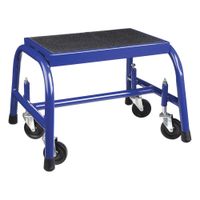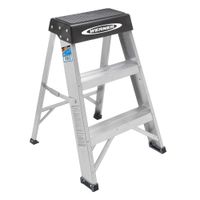Call +(254) 703 030 000 / 751 483 999 / 721 704 777
- Home
- Material Handling
- Ladders Platforms Personnel Lifts
- Step Stools
.....Read More
Frequently Asked Questions
What is the weight capacity of a step stool?
The weight capacity of a step stool varies depending on its design, materials, and intended use. Generally, most household step stools have a weight capacity ranging from 200 to 300 pounds (approximately 90 to 136 kilograms). These are typically made from materials like plastic, aluminum, or wood and are designed for light to moderate use, such as reaching high shelves or changing light bulbs.
For more robust applications, such as in industrial or commercial settings, step stools are often constructed from heavier-duty materials like steel and may have a higher weight capacity, often up to 500 pounds (about 227 kilograms) or more. These are designed to withstand more frequent use and heavier loads, making them suitable for environments like warehouses or workshops.
When selecting a step stool, it's crucial to consider the weight of the user and any additional weight they might be carrying while using the stool. It's also important to check the manufacturer's specifications and guidelines to ensure the stool is suitable for the intended use. Overloading a step stool beyond its weight capacity can lead to structural failure, posing a risk of injury.
Additionally, step stools are often rated by ANSI (American National Standards Institute) or OSHA (Occupational Safety and Health Administration) standards, which provide guidelines for safety and performance. These ratings can help consumers choose a step stool that meets their specific needs and safety requirements.
In summary, the weight capacity of a step stool can range from 200 to 500 pounds or more, depending on its construction and intended use. Always refer to the manufacturer's specifications and adhere to safety standards to ensure safe usage.
How do I choose the right height for a step stool?
To choose the right height for a step stool, first determine the specific tasks you need it for, such as reaching high shelves or changing light bulbs. Measure the height of the area you need to access. Subtract your own height and arm reach from this measurement to find the required stool height. Consider the stool's platform height, which is the top step where you'll stand. Ensure it provides enough elevation to comfortably reach your target without overextending.
Next, assess the stool's stability and weight capacity. Choose a stool with a wide base and non-slip feet for stability. Check the manufacturer's weight limit to ensure it can safely support you. Consider the number of steps; a single-step stool is suitable for minor height boosts, while a multi-step stool is better for higher reaches.
Evaluate the stool's portability and storage. If you need to move it frequently, opt for a lightweight, foldable design. Ensure it fits in your storage space when not in use. Material choice is also important; aluminum is lightweight and rust-resistant, while wood offers durability and aesthetic appeal.
Finally, consider safety features like handrails, locking mechanisms, and non-slip treads. Handrails provide extra support, especially for taller stools. Locking mechanisms prevent accidental folding during use. Non-slip treads reduce the risk of slipping.
By considering these factors—task requirements, stability, portability, material, and safety features—you can select a step stool that meets your needs and ensures safe, efficient use.
Are rolling step stools safe to use?
Rolling step stools can be safe to use if they are designed and used properly. These stools are often equipped with wheels or casters that lock when weight is applied, providing stability when someone steps on them. Key safety features to consider include:
1. **Locking Mechanism**: Ensure the stool has a reliable locking mechanism that engages when weight is applied, preventing movement while in use.
2. **Non-Slip Surface**: The top of the stool should have a non-slip surface to prevent slipping when stepping on or off.
3. **Sturdy Construction**: The stool should be made of durable materials that can support the intended weight capacity. Check for any weight limits specified by the manufacturer.
4. **Wheel Quality**: High-quality wheels or casters that roll smoothly and lock securely are essential for both mobility and stability.
5. **Height and Reach**: Choose a stool with an appropriate height for the tasks you intend to perform, ensuring you can reach safely without overextending.
6. **Environment**: Use the stool on a flat, stable surface to prevent tipping. Avoid using it on uneven or slippery floors.
7. **Regular Maintenance**: Periodically check the stool for any signs of wear or damage, such as loose parts or worn-out wheels, and address any issues promptly.
8. **Proper Use**: Follow the manufacturer's instructions for use and avoid any misuse, such as standing on the stool with more than one person or using it as a substitute for a ladder for tasks beyond its design.
By considering these factors and using the stool as intended, rolling step stools can be a safe and convenient tool for reaching higher areas in homes, offices, or workshops.
What materials are step stools typically made from?
Step stools are typically made from a variety of materials, each offering distinct advantages in terms of durability, weight, and cost. Common materials include:
1. **Wood**: Often used for its aesthetic appeal and sturdiness, wooden step stools are popular in home settings. They can be crafted from hardwoods like oak or maple, which provide strength and durability, or from softer woods like pine, which are lighter and more affordable.
2. **Metal**: Aluminum and steel are frequently used for step stools due to their strength and durability. Aluminum is lightweight and resistant to rust, making it ideal for both indoor and outdoor use. Steel, while heavier, offers superior strength and stability, often used in industrial or commercial settings.
3. **Plastic**: High-density polyethylene (HDPE) and other durable plastics are used for lightweight, portable step stools. Plastic stools are often more affordable and resistant to moisture, making them suitable for use in bathrooms or kitchens.
4. **Fiberglass**: Known for its strength and non-conductive properties, fiberglass is used in step stools designed for electrical work. It is lightweight and resistant to corrosion, making it a durable choice for various environments.
5. **Bamboo**: An eco-friendly alternative, bamboo step stools are lightweight and strong. Bamboo is a sustainable material that offers a natural look, often used in home settings for its aesthetic and environmental benefits.
Each material offers unique benefits, and the choice often depends on the intended use, required durability, and personal preference regarding weight and appearance.
How do I maintain and clean a step stool?
To maintain and clean a step stool, follow these steps:
1. **Regular Inspection**: Frequently check for any signs of wear and tear, such as loose screws, cracks, or rust. Tighten any loose parts and replace damaged components to ensure safety.
2. **Cleaning**:
- **Materials**: Use a mild detergent mixed with warm water for general cleaning. For metal stools, a mixture of vinegar and water can help remove rust.
- **Procedure**: Wipe down the stool with a soft cloth or sponge soaked in the cleaning solution. Pay special attention to the steps and joints where dirt accumulates.
- **Rinsing**: After cleaning, rinse the stool with clean water to remove any soap residue.
- **Drying**: Thoroughly dry the stool with a towel to prevent rust or water damage, especially if it’s made of metal or wood.
3. **Rust Prevention**: For metal stools, apply a thin layer of rust-resistant spray or oil to protect against corrosion. Ensure the stool is completely dry before application.
4. **Wood Care**: For wooden stools, apply a wood polish or wax periodically to maintain the finish and protect against moisture.
5. **Storage**: Store the stool in a dry, cool place away from direct sunlight and moisture to prevent damage. If possible, hang it on a wall or keep it off the ground to avoid contact with water.
6. **Usage Tips**: Always use the stool on a stable, flat surface. Avoid overloading it beyond its weight capacity to prevent structural damage.
By following these steps, you can ensure your step stool remains safe, functional, and in good condition for a long time.
Can step stools be used outdoors?
Yes, step stools can be used outdoors, but there are several factors to consider to ensure safety and durability. First, the material of the step stool is crucial. Metal step stools, especially those made from aluminum or stainless steel, are generally more suitable for outdoor use due to their resistance to rust and corrosion. Plastic step stools can also be used outdoors, but they should be UV-resistant to prevent degradation from sun exposure.
The design of the step stool is another important consideration. Look for step stools with non-slip surfaces and rubber feet to provide stability on uneven or slippery outdoor surfaces. Some step stools are specifically designed for outdoor use and may have features like wider steps or a broader base for added stability.
Weather conditions should also be taken into account. If the step stool is going to be left outside, it should be able to withstand rain, wind, and temperature fluctuations. It's advisable to store the step stool indoors or in a sheltered area when not in use to prolong its lifespan.
Finally, consider the intended use. For tasks like gardening, cleaning gutters, or reaching high places on the exterior of a house, ensure the step stool is tall enough and sturdy enough to support the user safely. Always follow the manufacturer's weight limit and usage guidelines to prevent accidents.
In summary, while step stools can be used outdoors, choosing the right material, design, and taking proper care can ensure they remain safe and functional in an outdoor setting.
What are the differences between stationary and rolling step stools?
Stationary step stools and rolling step stools serve similar purposes but differ in design and functionality.
Stationary step stools are fixed in place and do not have wheels. They are typically lightweight, making them easy to carry and reposition manually. These stools are stable and secure, providing a firm platform for reaching higher areas. They are ideal for tasks that require a steady base, such as changing light bulbs or accessing high shelves. Stationary stools often have rubber feet to prevent slipping and are available in various materials like plastic, metal, or wood.
Rolling step stools, on the other hand, are equipped with wheels or casters, allowing them to be easily moved without lifting. They are designed for environments where frequent repositioning is necessary, such as libraries, warehouses, or retail stores. The wheels often retract when weight is applied, converting the stool into a stable platform. This feature combines mobility with safety, as the stool remains stationary when in use. Rolling step stools are usually made of durable materials like metal or heavy-duty plastic to withstand frequent movement and use.
In summary, the primary difference lies in mobility: stationary step stools are fixed and manually repositioned, while rolling step stools offer ease of movement with retractable wheels for stability during use. The choice between the two depends on the specific needs of the user and the environment in which the stool will be used.

